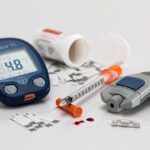I tell you, it’s your lifestyle
You can scan the internet, search on Google, and watch videos on YouTube all about diabetes, and you will see it over and over again. type 2 diabetes is reversible. But you have to be willing to change your lifestyle. More and more research is pointing to the processed foods we eat and the environment we live in. It seems our bodies just don’t care to be existing with man-made stuff. It’s like smoking, you may enjoy that cigarette after dinner, but your lungs and heart are choking on the stuff in the smoke. One cigarette isn’t going to kill you, but years of it will.
It’s the same thing with the food and environment. One day doesn’t kill you, but the wear and tear of the chemical we breathe in and the things we eat stress our body’s systems to the point they start to break down. Now add to the mix a genetic condition that makes you a little more susceptible to the threshold of developing type 2 diabetes and you there quicker than others.
So let’s talk about what a healthy diet environment would look like. Remember each person reacts to the environment in their own unique way. The higher your glucose/blood sugar is (either can be used), the more you will have to focus on lifestyle. Hopefully, you’ll be able to get back to something of a normal blood sugar level through lifestyle. You may have to take a prescribed drug to help get things under control, but as you lower your glucose levels you may be able to discontinue taking it. Of course, you’ll work with your medical professional to make those decisions.
Let’s get started on looking at key lifestyle changes that are available to help.
In a recent study
It is understood that lifestyle intervention is strongly suggested as the first step at the beginning of treatment of diabetes for all ages, it has been shown to be more effective when started early in the course of type 2 diabetes. Lifestyle intervention to prevent type 2 diabetes includes making changes in your eating habits, physical activity, and weight. Losing weight, eating healthy foods, and being physically active can help you manage your blood sugar and improve your overall health.
A key word here is “overall”. It’s not just diabetes that is being addressed, it improves your system overall. Your type 2 diabetes condition is greatly reactionary to your environment.
You need some carbs
Carbs are good for you, it’s where you get them from and how many carbs you eat. Yep, you’re going to have to count carbs. However, you can get your carbs from many places. Here’s a list of good carbs:
- Whole grains include brown rice, oatmeal, quinoa, millet, and amaranth
- Eating a baked sweet potato
- Of eating recipe food with whole gains made with a pinch of sugar (yes Virginia a pinch, not a hand full)
When growing up, did your mother tell you to eat your veggies? I’ll bet she did, I hated green beans. Well, it’s time to get back to your veggies. It’s hard to go wrong here. Most veggies are high in fiber and have little if any salt. I see you reaching for the salt shaker, put it down, and step away. Fiber helps slow down glucose entering the body. This helps control the sugar spikes after eating. A heads up here, frozen veggies are best vs canned veggies. Canned veggies will most likely have a lot more salt added.
Some really good veggies to eat are kale, spinach, and arugula. Iceberg ice lettuce is sort of like kissing your sister, no big deal. Iceberg lettuce doesn’t have a lot of nutrients in it. Oh, I said it’s hard to go wrong here, the part you can run into trouble is potatoes and corn. These have carbs, so you’ll have to take that into your carbs total when doing your meal planning. I confess I had corn on the cob and it was gooooood, but I had only one ear.
A good rule of thumb on veggies is to look for colors (dark red, green, orange, onions, nice white ones, and of course the purple eggplant.
A rule of thumb
Okay, let’s look at the fruit. There’s good news and bad news here. Fruit is on a whole good for you. You’ll get fiber, vitamins, and minerals. There’s low fat and sodium in most fruits. The bad news is there are carbs and controlling amounts will be important.
What about meats and protein? There’s a lot to choose from, here’s a list of items, starting with the best going to well, not as good as the first item.
- Number one on the list is plant-based foods like beans, seeds, nuts, and tofu (I can pass on tofu)
- Next is seafood and fish. (Remember seafood can have mercury)
- Chicken and poultry, love that skin from the chicken but it can fall into the bad group
- And wrapping up this list eggs and low-fat dairy foods
Cooking brings in oils and fats. You might even be guilty of adding something to sweeten things up a bit. These are necessary items, but use ones that are natural. Things like nuts, seeds, or avocados. They do have a lot of calories so go easy on them.
Finally, when it comes to things to drink, that can of soda may need to be cut back. Sugar is something you have to limit and soda is a lot of sugar. Better to drink water, with or without flavoring. Tea without sweeteners, love my coca tea. Surprisingly light beer and wine in moderation are something you can drink. If you drink coffee, good old black coffee is best. If you must add something, use low-fat milk and a sugar substitute.
Things to look out for
The first thing to look out for is processed foods. They put things in you don’t want to eat. Remember it’s the processing that’s where the bad stuff comes from. Natural is best. Avoid white bread, french fries, and veggies in a can. Other items to watch out for are fruity roll-up, and fruit in heavy syrup. Any fruit drink or punch. remember it’s the sugar we’re trying to cut back.
When cooking food remember to watch for things fried or deep-fried meats. Avoid lard and bacon (I love bacon) and whole dairy products. All of these make foods taste good, but your body will thank you. If it has trans fat just say no, you can add partially hydrogenated to the no list also. Check with your doctor about saturated fats. A large amount isn’t the best thing to have.
And finally
I tell you, it’s your lifestyle is more than diet and weight management. You also need to have an exercise program to burn the glucose in your blood. In the next article, we’ll look into the suggested exercise and the benefits that come with it. This is something you can do, your lifestyle can help you to a healthy life.
Please join our Facebook group and check out our other blog articles.







